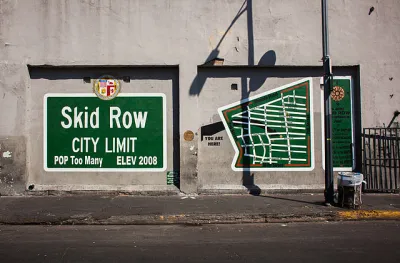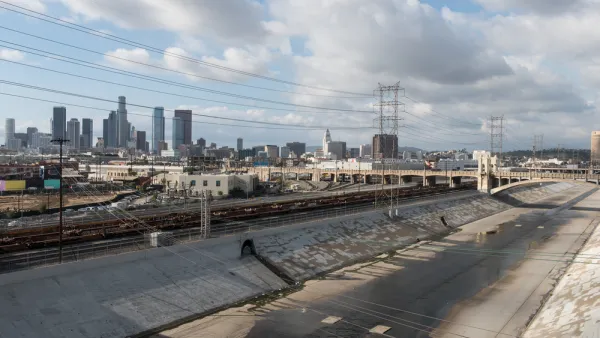A Los Angeles Times editorial argues that Skid Row’s future should learn from the mistakes of the past.

There’s a wrinkle included in the proposed community plan for Downtown Los Angeles (DTLA 2040) that has provoked concern from observers, including an editorial from the Los Angeles Times.
The wrinkle in question is a zoning district in the city’s Skid Row that would only allow affordable housing development. The blocks between between 5th and 7th streets and San Pedro Street and Central Avenue would be zoned as IX1, a new zone allowing for “mixed industrial use.” According to the Los Angeles Time Editorial Board, the new zone will create “the first area of the city with new housing reserved for residents defined as acutely low income (homeless or almost) to moderately low income.”
As noted in the editorial, however, the state of Skid Row in 2023 is a result of a 1970s approach to homelessness that concentrated services in this one section of the city near Downtown.
“In the 1970s the city adopted an official policy of ‘containment’ — concentrating cheap hotels, shelters and service agencies on skid row to both take care of residents and prevent them from setting up in other parts of downtown or the city. It was born of a desire by leaders to help and also to wipe their hands of the misery there,” explains the editorial.
Skeptics of the new zoning code point out the similarities between the new plan with the containment of previous decades. The editorial, however, calls for a new future for Skid Row—one that allows both affordable housing and market-rate housing.
The editorial, linked below, proposes a solution that would require higher portions of affordable housing, or a cap on market rate development in the area. “The goal in this particularly impoverished community is to make room for more housing and more investment to lift up the neighborhood. Making skid row more of a mixed-income community need not displace current residents or services, if done carefully,” according to the editorial.
FULL STORY: Editorial: Let skid row have affordable and market-rate housing. It’s the forward-looking thing to do

National Parks Layoffs Will Cause Communities to Lose Billions
Thousands of essential park workers were laid off this week, just before the busy spring break season.

Retro-silient?: America’s First “Eco-burb,” The Woodlands Turns 50
A master-planned community north of Houston offers lessons on green infrastructure and resilient design, but falls short of its founder’s lofty affordability and walkability goals.

Delivering for America Plan Will Downgrade Mail Service in at Least 49.5 Percent of Zip Codes
Republican and Democrat lawmakers criticize the plan for its disproportionate negative impact on rural communities.

Test News Post 1
This is a summary

Test News Headline 46
Test for the image on the front page.

Balancing Bombs and Butterflies: How the National Guard Protects a Rare Species
The National Guard at Fort Indiantown Gap uses GIS technology and land management strategies to balance military training with conservation efforts, ensuring the survival of the rare eastern regal fritillary butterfly.
Urban Design for Planners 1: Software Tools
This six-course series explores essential urban design concepts using open source software and equips planners with the tools they need to participate fully in the urban design process.
Planning for Universal Design
Learn the tools for implementing Universal Design in planning regulations.
EMC Planning Group, Inc.
Planetizen
Planetizen
Mpact (formerly Rail~Volution)
Great Falls Development Authority, Inc.
HUDs Office of Policy Development and Research
NYU Wagner Graduate School of Public Service




























